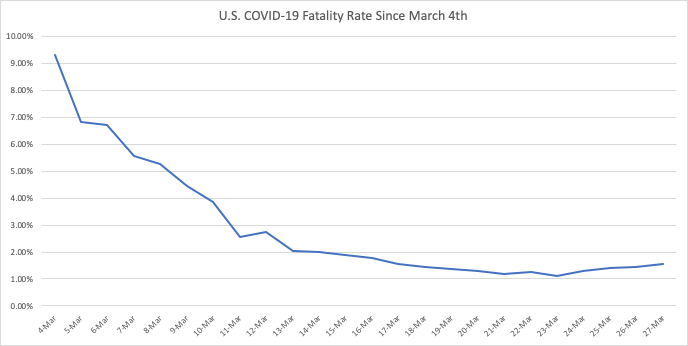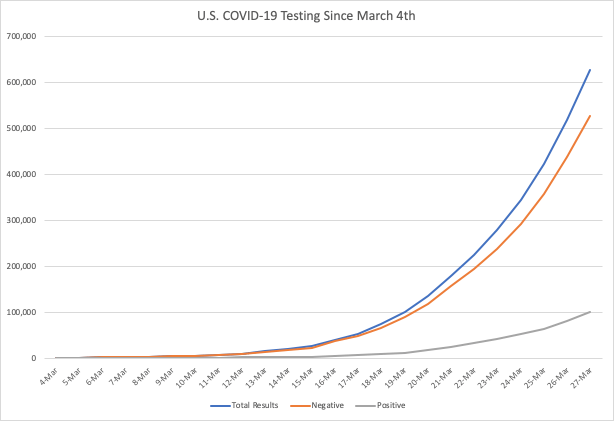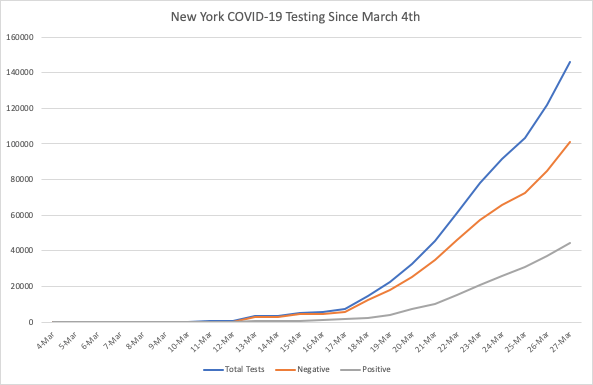What Does the Growing Number of Coronavirus Cases Really Mean?

As COVID-19 continues to have its political impact, ranging from state mandates to close certain businesses to cities imposing curfews to road closures, the headline numbers continue to get the most attention: the number of cases and the number of deaths.
After several weeks of efforts to contain, treat, and measure the impact of the coronavirus, the data support one of two conclusions:
1. The virus is highly contagious, with the number of infected people doubling every three days.
OR
2. The fatality rate is significantly higher than for the seasonal flu.
But we cannot really believe both.
If the first claim is correct, then even though there are approximately 100,000 confirmed cases in the U.S., the virus has been spreading much more rapidly than we can test for it, if it has truly doubled every three days since January. If COVID-19 truly spreads that quickly, then the true number of infected in the U.S. is much higher – perhaps several million, as Stanford School of Medicine researchers Eran Bendavid and Jay Battacharya suggest in the Wall Street Journal.
If millions have been infected, then it logically follows that the current number of confirmed cases vastly understates the true number of infected. But even if only two million people have been infected (which would suggest a slower growth rate than the models projected), then the number of deaths as of Friday (just over 1,500) yields a fatality rate of just under 0.08 percent, or slightly less than the seasonal flu.
If there are several million infected, then the fatality rate is a small fraction of the seasonal flu, perhaps as low as 0.01 percent. Those numbers would suggest that the U.S. is facing a new virus with flu-like symptoms, one that, like many viruses, is a dangerous threat to those with weak immune systems or respiratory problems. But ultimately it is milder and far less deadly than last year’s seasonal flu.
The alternative is to believe that the fatality rate is as high as the reported numbers suggest, 4.5 percent globally, or about 1.2 to 1.6 percent in the U.S. (see the chart below). If so, then the virus is unusually difficult to transmit. If we just go by confirmed cases, then only about 80 thousand people have been infected in China, out of a population of 1.38 billion, or 0.006 percent.
Or that so far, after over three months, the coronavirus has only infected 617,000 people globally, or roughly 0.008 percent of the population. If we believe the number of cases is more or less right, then the virus spreads much more slowly than imagined.

The challenge in knowing how fast the virus spreads, which gives us the true number of cases, is testing. The virus spreads more quickly, at this stage, than we can test for it. And without knowing the true number of cases, we cannot accurately calculate the true death rate.
Nonetheless, the growth in testing has shed light on both questions, the spread of the virus and its deadliness. The chart above shows that as testing expanded, the case fatality rate fell. The chart below shows the growth in testing and which portion of those tests have been positive. The latest data on testing show that nationally roughly 16 percent of tests issued are positive, but in New York the number of positive tests is over 30 percent (see the third chart).


The charts suggest that New York State either has a higher infection rate than the rest of the country (which is plausible given the higher population density), or that testing in New York has been even more focused on the seriously ill than is the case nationally. While the former is likely true, there is also evidence for the latter: New York’s hospitalization rate for confirmed cases (19%) is five percent higher than the current national average (14%).
So which is it, is the virus spreading very rapidly or is it especially deadly? Given what we know about how similar viruses spread, it seems reasonable to believe the virus spreads more rapidly than the testing data indicate, and that the true number of cases is many times larger than 100,000.
The infected are likely in the millions, but the rationing of tests prevents us from knowing the true number. In any case, that means the death rate is vastly overstated, and likely even lower than what has been typically reported for the seasonal flu. But there is also reason to believe that the coronavirus, while highly contagious in the same sense that many common viruses are, is not really more contagious than the seasonal flu. To believe that, we would have to believe the total number of infected is in the tens of millions nationally, even with the social distancing measures in place.












